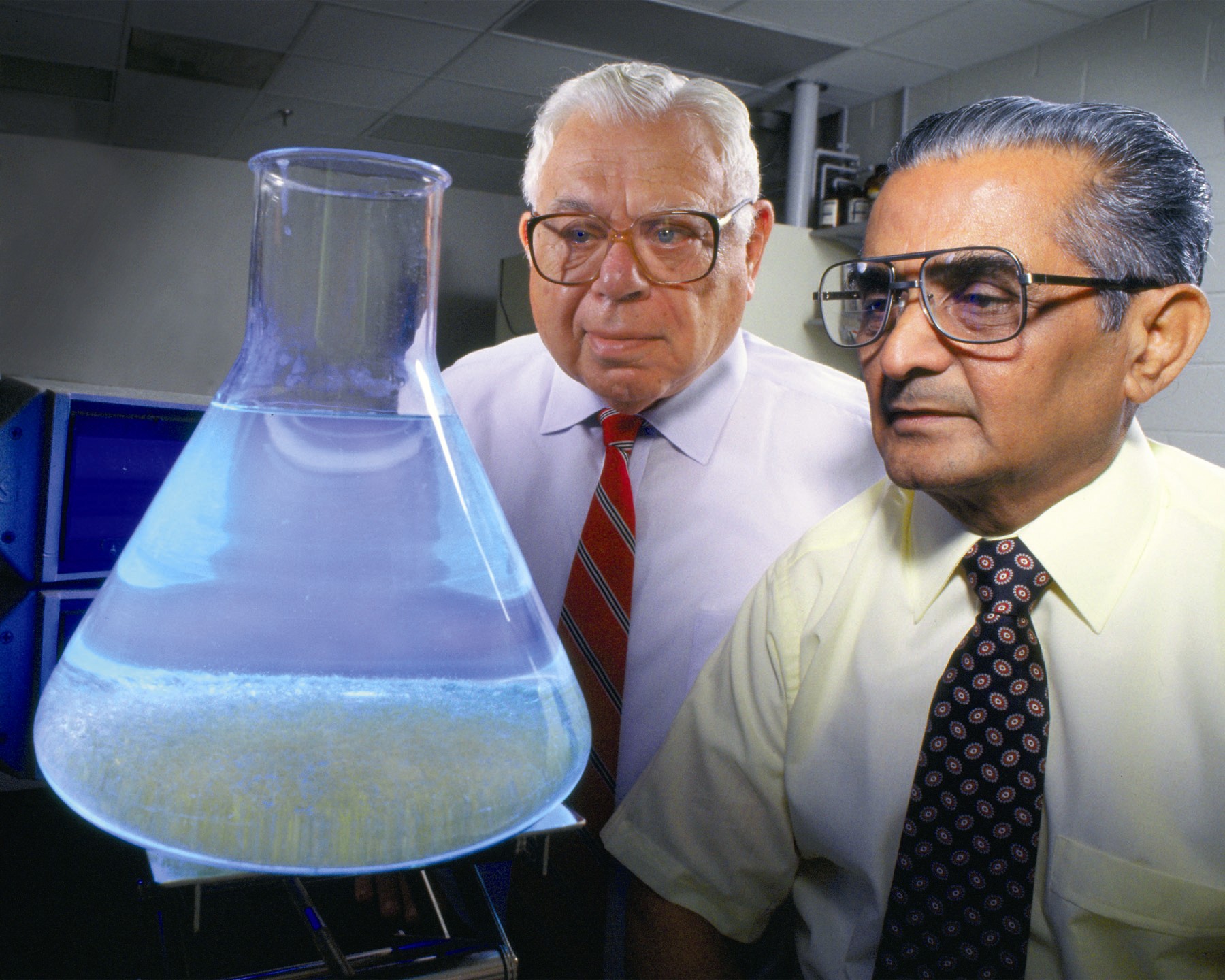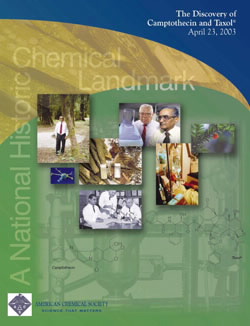Discovery of Camptothecin and Taxol
Dedicated April 23, 2003, at the Research Triangle Institute in Research Triangle Park, North Carolina.
Monroe Wall, Mansukh Wani and colleagues at the Natural Products Laboratory of the Research Triangle Institute discovered and elucidated the structure Taxol® and camptothecin, two life-saving compounds for the treatment of cancer. These natural products kill cancer cells via unique mechanisms of action and in ways scientists had not previously imagined. The work of this research team led to the eventual development and marketing of drugs that have been approved for treatment of ovarian, breast, lung, and colon cancer and Kaposi’s sarcoma.
Contents
Cancer Research History Before 1960
The discovery of penicillin and its successful production and distribution during World War II ushered in the modern age of antibiotics. The success of these new drugs convinced many that diseases could be eradicated chemically. The discovery of additional antibiotic drugs such as erythromycin and tetracycline changed mortality patterns drastically: By the 1950s deaths from infectious diseases, especially pneumonia, began to decline and heart disease and cancer became major killers. Interest in cancer research, especially chemotherapy, intensified with the increase in cancer deaths.
The history of chemotherapy is rooted in research in gas warfare conducted by the United States and Britain during World War II. That experience convinced some researchers that chemical agents could be used to destroy or control the growth of cancer cells, the core definition of chemotherapy. After the war, experiments were conducted using nitrogen mustards to fight leukemia. Much of this work was done at the Sloan-Kettering Institute for Cancer Research in New York City where many of the scientists who had worked in the Chemical Warfare Service during wartime relocated in peacetime.
About 75% of the compounds evaluated as potential cancer fighters in the early 1950s were tested at Sloan-Kettering. But the institute’s capacity could not satisfy the needs of the scientific community, and demands mounted for creation of a national cancer drug screening program. At the same time, public pressure to do something about cancer increased, and it found voice in the lobbying efforts of the American Cancer Society, which agitated for increased funding for research. As a consequence, the budget of the National Cancer Institute (NCI) grew from $0.5 million in 1937, its first year, to $1.75 million in 1946 and $14 million in 1951 (ten years later the budget reached $110 million). And there was more money from the National Institutes of Health and from private sources for research grants. By the early 1950s cancer research had become well funded.
But it was not well organized. To correct deficiencies in the evaluation of potential drugs, NCI created the Cancer Chemotherapy National Service Center (CCNSC) in 1955 to act as a public screening facility using standardized procedures for compounds submitted by companies and institutions. Initially, CCNSC evaluated mostly compounds whose chemical structures were well known, such as synthetics and fermentation products. In 1960 the program began to screen extracts of natural products, both plant and animal, as complex mixtures of compounds of unknown structures. By that year CCNSC was screening 30,000 samples a year, about ten times Sloan-Kettering’s volume.
Humans have long used plants for a multitude of medical purposes. Before 1960 very few of these had been studied systematically, and even fewer had been examined for anticancer activity. While there was a great deal of folkloric knowledge about the general medicinal properties of plants, virtually nothing was known about the cytotoxic and antitumor potential of plants.
The organizer of the NCI plant program was Jonathan Hartwell, an organic chemist who in 1958 became Assistant Chief for Program Analysis Activities at CCNSC. Hartwell in a sense grew up with NCI, becoming a research fellow shortly after the Institute opened its doors. He was the perfect choice to head the plant screening project because he had wide experience in natural products chemistry and he believed that plants had chemotherapeutic potential. Hartwell compiled a comprehensive work on the traditional use of plants to treat cancer, complete with references to the literature of the ancient Chinese, Egyptians, Greeks and Romans.
Hartwell’s interest in what he called “cancer plants” went beyond folklore. In the early 1950s, in a study of plants known to be biologically active, NCI had investigated savin, Juniperus sabina, a small juniper bush that showed some anticancer activity. The results proved mediocre in the end, but the search was on for active conifers. To find specimens and to obtain accurate botanical information, Hartwell turned to the United States Department of Agriculture. In June 1960 NCI and the USDA agreed on a cooperative program to supply NCI with plants for anticancer screening. During the next two decades USDA botanists collected plants throughout the United States with the goal of providing a broad taxonomic cross-section of plants for screening.
Samples of plants obtained by the USDA were sent to the Wisconsin Alumni Research Foundation, which prepared the crude extracts. These in turn were sent to various laboratories for testing in a number of bioassay systems to see if they had a potential for killing cancer cells. In the initial years of the program samples were tested in one in vitro screen, KB (oral epidermoid carcinoma) cell culture, a cell line from a human cancer. They were also tested in three in vivo screens in tumors planted in laboratory mice. The in vivo screens were for S-180, a sarcoma; CA-755, an adenocarcinoma; and L1210, a lymphoid leukemia.
The crude extracts that showed potential for activity became candidates for fractionation, a process geared to isolate the active compounds. Fractionation was done at three laboratories, one of which was the newly organized Research Triangle Institute (RTI) in North Carolina which opened in 1958 and which two years later hired Monroe Wall to head its Natural Products Laboratory. Wall had been in charge of a program at the USDA’s Eastern Regional Research Laboratory that analyzed plants growing throughout the United States in the search for phyto-steroids that could serve as precursors to cortisone, which was in great demand but of limited supply at that time. A thousand extracts of plants sampled over the ten years of this project were sent to NCI to test their anticancer potential. One of them, Camptotheca acuminata, a tree native to China, demonstrated potent anticancer activity in the CA-755 assay. Work on isolating the compound responsible for this activity moved to RTI with Wall in 1960.
Discovery of Camptothecin™
In 1966 Monroe Wall wrote of his work at the Eastern Regional Research Laboratory: “The joint effort of chemists and botanists proved to be a good model for future programs. Indeed, it firmly established the fact that the close cooperation between chemists and botanists was required for a successful natural products program.”1
Monroe Wall was born in Newark, New Jersey, in 1916 and earned his undergraduate and graduate degrees from Rutgers University. In 1941 he joined the USDA’s ERRL in Philadelphia where he worked on potential agricultural alternatives for products, such as rubber, critical to the war effort. After the war, he became involved in plant screening, and in 1957 a chance visit from Jonathan Hartwell of the Cancer Chemotherapy National Service Center changed the course of Wall’s career.
It was Hartwell who convinced Wall to send NCI one thousand ethanolic plant extracts for antitumor activity testing. A year later Wall learned that one of the plants demonstrated potent activity: Camptotheca acuminata. But the USDA was not interested in anticancer drug research, so Wall’s ambition to identify the active component in C. acuminata had to be put on hold until July 1960 when the Research Triangle Institute recruited him. According to Mansukh Wani, an organic chemist born in Bombay, India, who Wall lured to RTI in 1962, the Institute was “nothing but four ‘walls.’ It was not until the fifth ‘Wall’ arrived that the chemistry programs, in the form of the Natural Products Laboratory, started moving.”2
Wani describes Wall as “a go-getter” and “a very dedicated scientist.” About Wall, Wani adds, “persistence was his greatest virtue, but patience was not.” Wall and Wani collaborated for forty years, a collaboration that began with research into the nature of the compounds responsible for the antitumor activity in C. acuminata.
By 1963 RTI had an approximately 20 kg sample of the wood and bark of C. acuminata available, and Wall and Wani and colleagues at RTI began what they describe as ‘bioactivity-directed fractionation.’ In this the crude plant extract is purified in an iterative manner. At each stage the ‘fractions’ are tested for bioactivity. Those fractions showing the most potent activity are carried on to the next stage of purification. The process is repeated many times until the compound(s) responsible for the bioactivity observed with the crude extract are isolated. In the 1960s this was a difficult and slow process requiring great skill and intuition on the part of the researchers using equipment that can now be found only in museums.
By the time Wall and Wani began fractionating their samples it was known that C. acuminata was very active in the L1210 mouse leukemia assay, which was unusual since most plants did not exhibit such activity. It was this activity that had aroused the interest of NCI. All of the fractions of the extract were analyzed both by the in vivo L1210 mouse life prolongation assay and by the KB in vitro cytotoxicity assay. The pure compound isolated as a result of the fractionation was given the name camptothecin and it was shown to be the agent that was not only very active against L1210 leukemia but also against P388 leukemia cells.
RTI scientists Keith Palmer and Harold Taylor did the original isolation of camptothecin, and Ed Cook worked on determining its structure. At that point, Wall asked Wani, who he described as having “the knack to work on small amounts of material,” to prepare a camptothecin derivative for single X-ray crystallography. The derivative was sent to Andrew McPhail and George Sim at the University of Illinois who reported back within a few weeks the tentative structure of camptothecin, which is unusual although it is related to the indole alkaloids. The research on the isolation and structure of camptothecin was published in 1966 in the Journal of the American Chemical Society, the first paper Wall, Wani and colleagues published on a natural product with anticancer potential. Wani describes the isolation of camptothecin as “the most exciting scientific event in my life.”3
Because camptothecin showed such promising antitumor activity, the NCI decided to proceed with clinical trials. But camptothecin is not soluble in water (which makes delivery of a potential drug difficult) so the trials were conducted with a water-soluble sodium salt that could be formulated for intravenous delivery. In the trials, some patients with gastrointestinal tumors responded to treatment for a short time.
Despite some encouraging successes, the use of camptothecin as an anticancer agent languished for almost fifteen years until its unique mode of action for killing tumor cells was determined. Camptothecin traps an important cellular enzyme, topoisomerase I, in complexes with DNA. This prevents cancer cell DNA replication and results in the death of the cancer cell. This unique mode of action rekindled interest in developing analogs of camptothecin that were both water soluble and retained anticancer activity. In the mid-1990s, two camptothecin analogs, topotecan and irinotecan, received FDA approval for use against ovarian, lung, breast and colon cancers.
Wall and Wani worked with many plant samples in the 1960s in addition to C. acuminata. One of these samples came from the bark of Taxus brevifolia, a tree that was to have a much more convoluted history in the annals of drug development than C. acuminata, but which would eventually yield one of the most potent chemotherapy agents yet developed.
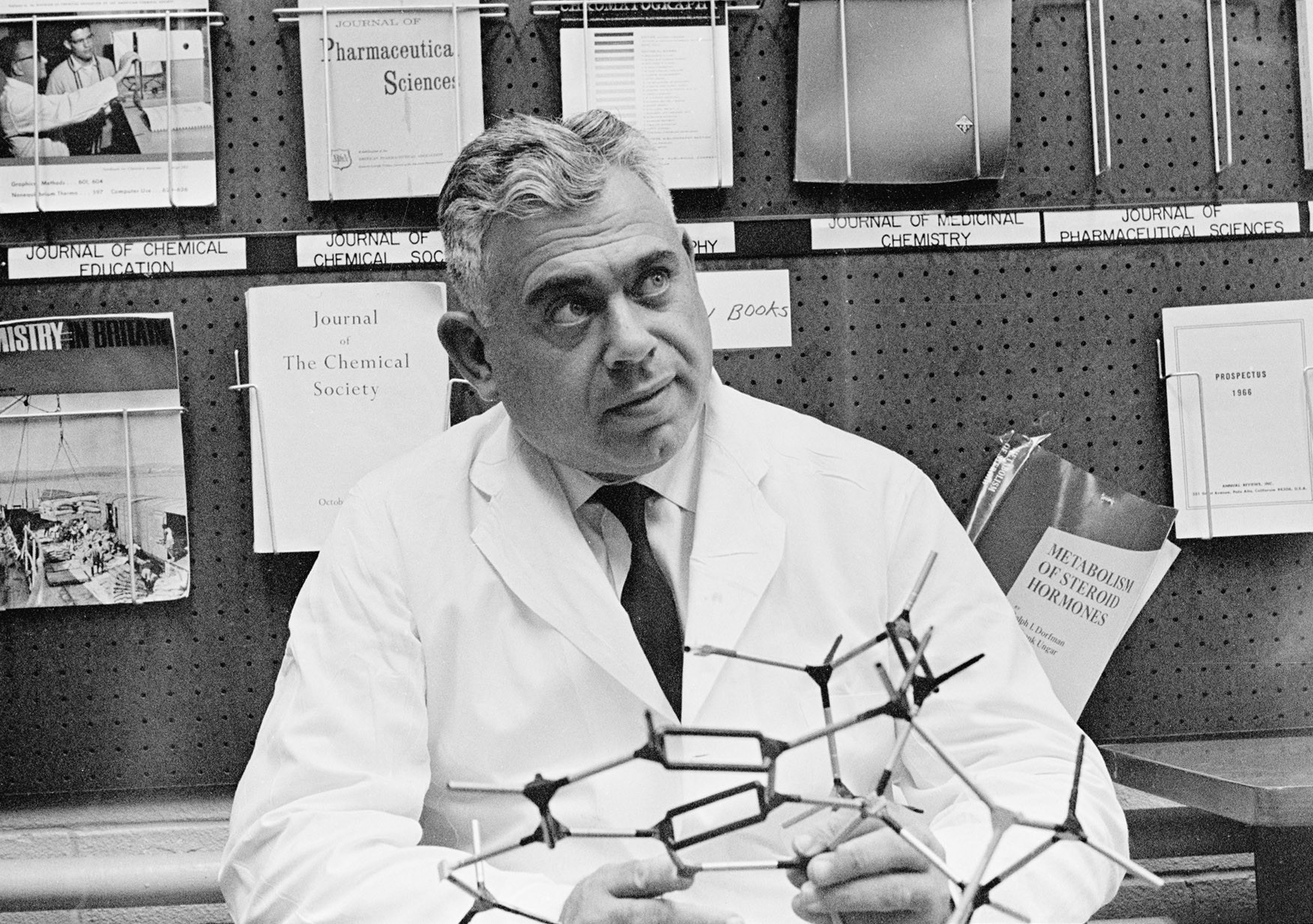
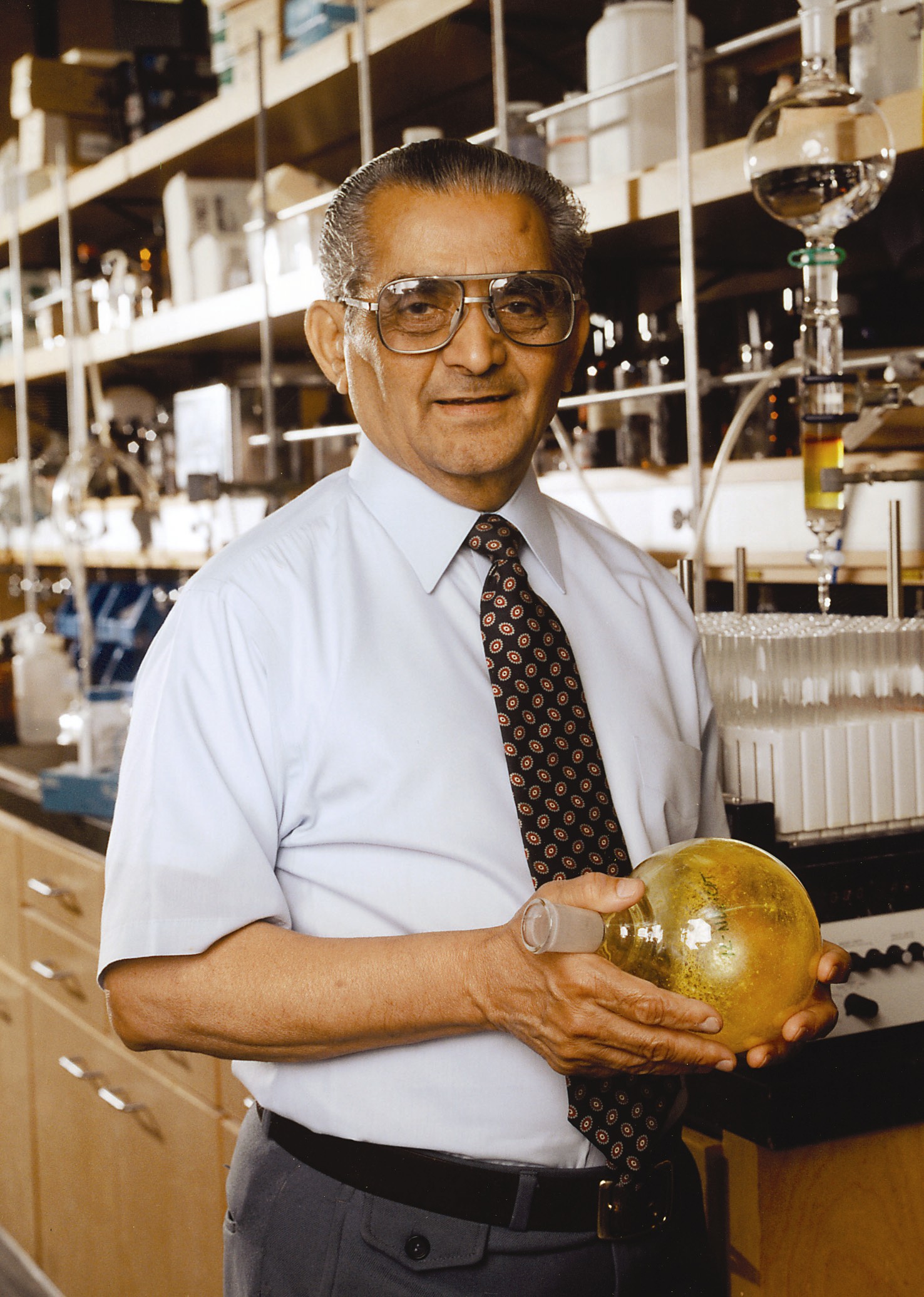
Exploring Natural Sources: The Pacific Yew
On a hot August day in 1962 Arthur Barclay stood in Washington State’s Gifford Pinchot National Forest staring at a small stand of scraggly conifer trees. A Harvard-trained botanist, Barclay worked for the New Crops Research Branch of the Agricultural Research Service, an arm of the USDA. In the stand, at an elevation of 1,500 feet, Barclay spotted a twenty-five foot tall Pacific yew tree, Taxus brevifolia, which he designated B-1645 (so named because it was the 1645th plant sample collected by Barclay). Barclay and his three graduate student assistants collected two samples: PR-4959, stem and fruit; and PR-4960, stem and bark.
Barclay collected T. brevifolia, an evergreen, apparently because the strategy was to collect at random. Not much was known about the tree. It belonged to the genus Taxus, the yew, one of five genera in the Taxaceae family. The yew is native to the Americas, Europe and Asia. The Pacific yew, T. brevifolia, is a tree of medium height with reddish bark and flat, slightly curved needles about an inch long. It lives in the shade of giant conifers on the banks of streams, deep gorges and damp ravines. It has hard wood that is of limited use. It has few natural pests because most of it is poisonous. And, significantly for the future, the Pacific yew grows very slowly.
Humans have made use of the yew since the dawn of history. A spear point made of yew found in England is thought to be 50,000 years old. In the Alps, an unfinished six-foot yew bow was found alongside the mummified remains of a man who died 5,300 years ago. The ancient Egyptians made household implements and weapons of yew. Homer described archers besieging the walls of Troy with yew bows. Rome armed its legions with yew lances, pikes and bows. The Celts used yew for tools and weapons. The yew influenced English history; Kings Harold, William II, and Richard Lion-Heart were killed with yew bows.
Because it is poisonous and because it was long used to make weapons, the yew has mythological associations with death. The Greeks believed the yew sacred to Hecate, goddess of the underworld. The scientific name for the yew, taxus, is eerily similar to the Greek word for bow and poison, toxon and toxicon. The Romans also associated the yew with death, using yew boughs in funeral ceremonies.
This mythology, which focused on the European yew, Taxus baccata, undoubtedly contributed to the scientific interest in the tree. An alkaloid, taxine, was isolated in 1856 and found responsible for the European yew’s poisonous nature. But there had been little scientific interest in the Pacific yew, T. brevifolia. That would change in the 1960s when Arthur Barclay’s collections reached the Research Triangle Institute.
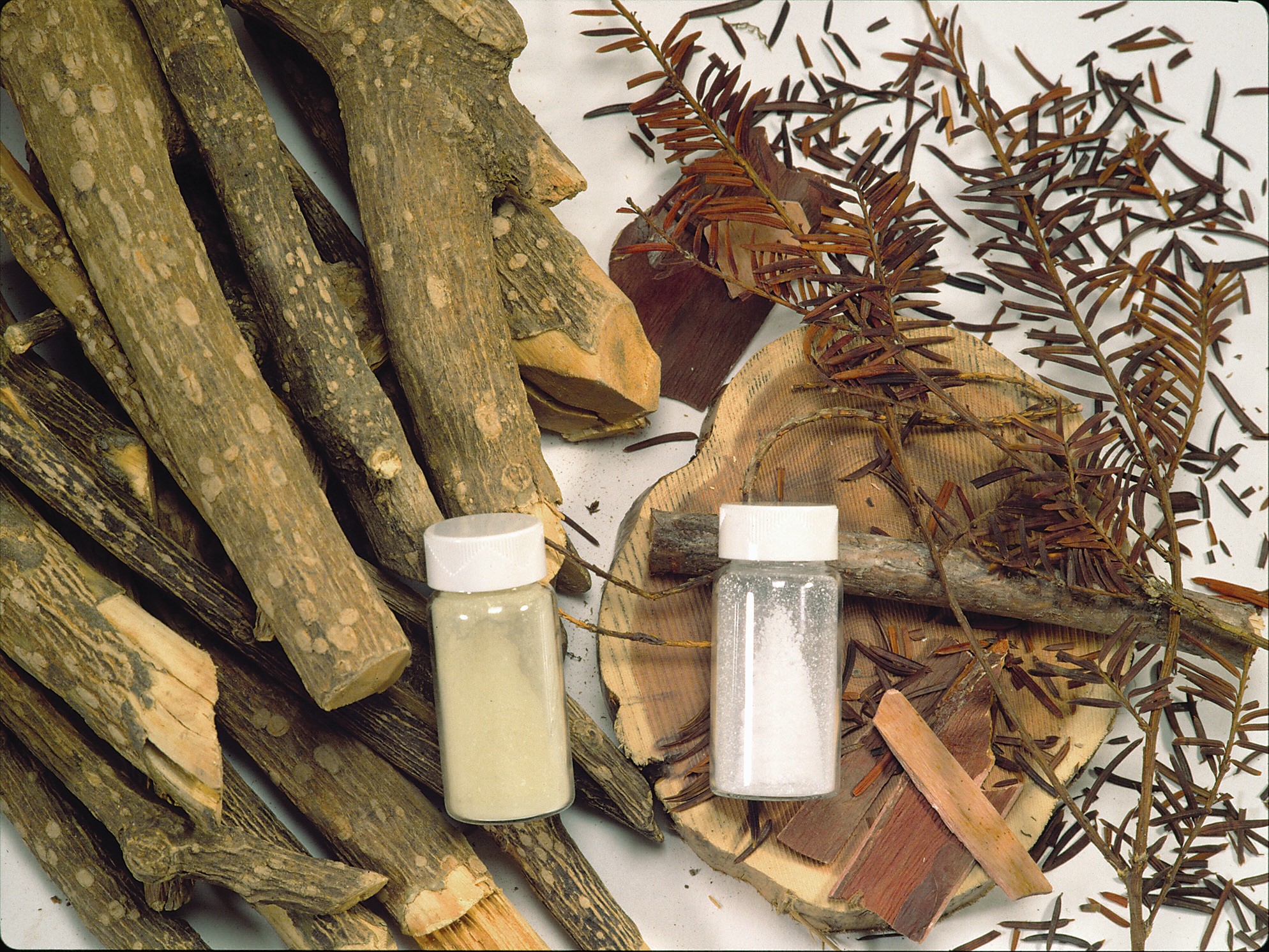
Discovery of Taxol®
Both of Arthur Barclay’s samples of Taxus brevifolia were sent to the Wisconsin Alumni Research Foundation for extraction. One of the samples, PR-4960, the bark, showed cytotoxicity against KB. Though the in vivo tests on L1210 leukemia yielded mixed results, further KB tests confirmed anticancer activity. Accordingly, the crude plant extract was designated NSC670549 to conform to CCNSC protocols. And Jonathan Hartwell of the Center instructed his counterpart at the USDA, Robert Perdue, to take steps to collect larger quantities of the bark of T. brevifolia for further evaluation.
On September 8, 1964 Barclay returned to the spot where he had originally collected PR-4960 and bagged thirty pounds of bark from T. brevifolia, which was shipped to Monroe Wall at the Research Triangle Institute after other laboratories turned it down. These laboratories were reluctant because plants that exhibited high cytotoxicity turned out to be poor drug candidates since they are toxic to everything, killing healthy cells as well as cancerous ones. But Wall was interested because of his experience with Camptotheca acuminata, which was highly cytotoxic but from which his group had isolated a compound that showed great promise.4
When it received Barclay’s shipment of bark, RTI began a bioassay-directed fractionation to isolate the pure compound in T. brevifolia responsible for its anticancer activity. In September 1966 the researchers isolated from one of the fractions a crystalline substance they designated K172 (after NCI practice in which pure compounds were identified with a “K” prefix). Since it was common practice for a laboratory to name compounds extracted from material assigned to it, Wall decided to name the substance “taxol.” He came up with the name for two reasons. First, while the RTI scientists did not yet know the compound’s complete structure, they were sure it contained some hydroxyl groups, signifying it was an alcohol. And second, it was common to name a molecule after the genus of the plant from which it came. Accordingly, the molecule became known as Taxol®—“tax” for Taxus and “ol” for alcohol. Besides, the name “had a nice ring to it.”5
Initially, Mansukh Wani reported some success in characterizing the isolated compound. But by early 1967 Wani had to admit failure in his attempts to characterize the active compound, unable even to determine its molecular weight. This initial work on the Pacific yew coincided with the isolation of camptothecin, which was “looking very hot” and on which NCI was ready to begin clinical trials.6 Moreover, RTI had many other plant extracts to evaluate.
At that point Wall told Wani “to forget about” Taxus brevifolia. But Wani persisted. He refused to give up on the yew completely, continuing to work on it “on a low priority basis.” Even this proved difficult because, as Wall wrote thirty years later, “the basic problem was that NCI had at that time (1966-1973) a rather rigid protocol which had to be met in order to obtain larger quantities of a natural product, and for carrying out expensive antitumor assays, toxicology assays, etc.”7
The need for more and more bark was compounded by the fact that the yield of Taxol® from collected bark was very low. This slowed the process to determine the molecule’s structure. To definitively learn the structure of Taxol®, Wall and Wani used mass spectrometry, X-ray crystallography and NMR spectroscopy, a technique then in its infancy. These various tools produced the molecular structure with a formula of C47H51NO14. Wall and Wani also discovered that Taxol® was two molecules in one—a large molecule connected to a small tail or side chain. In 1971 Wall, Wani and co-workers published the results of their work on Taxol® in the Journal of the American Chemical Society as a communication to the editor in which they stressed the antileukemic and antitumor activity of the newly isolated and elucidated molecule.8 Interestingly, the structure of Taxol® is so complex that Wall and Wani almost went to press with the side chain of the molecule placed in the wrong position.9
Wall and Wani at this point passed Taxol® to the NCI for further study of its anticancer properties in the hope that advanced animal studies and toxicological tests would eventually lead to human clinical trials. But NCI administrators showed great reluctance to pursue Taxol® for a number of reasons. Isolation and extraction of Taxol® from T. brevifolia was arduous and the tree, not all that prevalent, produced only small amounts of the compound. Each tree yielded only about two kilograms of bark and it took in the early days of testing about 12 kilograms of dried bark to obtain one-half gram of Taxol®. Moreover, bark is a finite resource; a tree stripped of its bark dies.
Because of the supply problem Taxol® literally stayed on the shelf at RTI for the next few years. But then several things happened to bring renewed interest in Taxol®. Matthew Suffness joined NCI, conducting a review of the natural products program and encouraging tests that showed Taxol® very active against B16 melanoma, a newly adopted tumor model. Almost at the same time, NCI introduced other new tumor models, called xenografts, in which human tumors are planted in what are called nude mice. These specially bred mice are called nude because they are hairless. More importantly, these mice lacked a functioning immune system, which meant their bodies would not reject transplanted human tumors. In November 1978 Taxol® showed the ability to cause considerable regression in a mammary tumor xenograft. And finally, interest in Taxol® increased greatly in 1979 when Susan Horwitz demonstrated that Taxol’s® mechanism of action was unique.
Commercialization of Taxol®
In August 1978 Monroe Wall received a letter from John Douros, who had replaced Jonathan Hartwell at the CCNSC, that read: “Dear Monroe: Can you help this poor girl?” Attached was a letter from Susan Horwitz asking for some radiolabeled Taxol® to conduct experiments on its mechanism of action. Like many researchers, Horwitz, a molecular pharmacologist in the Albert Einstein College of Medicine at New York’s Yeshiva University, had been hearing reports about Taxol®. She had managed to obtain a few milligrams of the substance, which she used to kill cancer cells growing in a culture. Determined to find out how it worked, Horwitz pressured NCI to get her more Taxol®.
Supply remained a problem. In July 1977 Matthew Suffness of the NCI placed an order with the USDA for 7,000 pounds of bark, which meant killing about 1,500 trees. Such a large order attracted the attention of environmentalists who began to wonder about the government’s sudden interest in the Pacific yew, long considered a “trash tree.” To environmentalists the tree, scattered in patches hidden within millions of acres, had a place in the virginal, old-growth forests of the Pacific Northwest. Environmentalists feared a massive attack on the Pacific yew would spell ecological disaster for the region. In the next decade this fear became enmeshed in the debate over the northern spotted owl, which lived in the forests of the Pacific Northwest and which the federal government eventually declared threatened.
Horwitz was able to get enough Taxol® to run tests that revealed its lethal secret, which turned out to be a mechanism completely new to scientists. Previous compounds killed cancer cells by inhibiting their division; they did this by preventing the production of ultra-fine filaments called microtubules that enable cells to divide. Cells manufacture millions of microtubules and use them as building blocks for a new cell. When a new cell breaks off, the microtubules become fragments of the protein tubulin. Before Taxol® anticancer agents worked by inhibiting the polymerization of tubulin to form microtubules; hence, the cells could not divide.
Horwitz discovered that Taxol® worked differently. Instead of preventing the formation of microtubules, it stimulated their development. Cells treated with Taxol® begin churning out so many microtubules that they are unable to coordinate cell division. As a result, cells die of continued attempts to replicate their DNA in the absence of the ability to divide.
Armed with this information, Suffness at NCI was able to argue that, because of its unique structure and mechanism of action, Taxol® was a candidate for further development. Buttressing that argument was Taxol’s® success in causing regression in the mammary tumor xenograft. Suddenly, Taxol® was “hot,” with some seeing it as a potential “miracle drug.”
Then came a disastrous discovery: Taxol® is virtually insoluble in water. No matter how good Taxol® was shown to be, if it could not be added to a medium so that it could be administered intravenously, it was worthless. Without any way of getting Taxol® into a patient, clinical trials could not begin. But after a year of looking, the NCI drug formulation team found that Taxol® dissolved in a special elixir made of castor oil and marketed as Cremophor EL. This paved the way for Taxol® to move into clinical trials on humans.
Taxol® progressed fairly smoothly through clinical Phase I and Phase II trials, once patients were premedicated to suppress severe allergic reactions to Cremophor EL. In fact, the results of Phase II trials against refractory ovarian cancer showed a previously unheard of response rate of thirty percent. The clamor about Taxol® intensified, forcing NCI to do the math. If Taxol® were made available to all victims of ovarian cancer, the institute would have to produce 240 pounds of the drug. That would mean killing 360,000 Pacific yews. It did not take a mathematical prodigy to understand that this was an equation without a future.
The numbers encouraged scientists to search for a synthesis, to in effect short cut nature. The first success story came in France, where Pierre Potier looked at a semi-synthesis. From the needles of the ubiquitous Taxus baccata, or English yew, Potier extracted 10-deacetylbaccatin III, commonly known as 10-DAB. The English yew is loaded with this compound, which contains the complex core of Taxol® minus the relatively simple side chain. Most importantly, 10-DAB comes from the needles, a renewable resource. After several years of trying, Potier and his colleagues succeeded in marrying 10-DAB to a synthetic version of the tail to achieve a semi-synthesis of Taxol®. This accomplishment led to the development of a plethora of semi-synthetic versions of Taxol®. Eventually, Robert Holton and colleagues at Florida State University developed a commercially viable semi-synthetic procedure.
With the clinical trials going well the NCI began to look for a pharmaceutical company willing to take a chance on turning Taxol® into a marketable drug. In August 1989 the institute advertised that it had a cooperative research and development agreement to issue to the company with the best proposal. Later in the year, the grant went to Bristol-Myers, soon to merge with Squibb, another giant in the field. Bristol-Myers Squibb worked out a deal with Holton under which it agreed to use his semi-synthetic process for the production of Taxol®.
In December 1992, thirty years after USDA botanists first sampled Taxus brevifolia in a Washington State forest, and more than twenty years after Wall and Wani reported the isolation and structure of Taxol®, the Food and Drug Administration granted approval for Taxol’s® use against refractory ovarian cancer. It has since been approved for use in the treatment of breast cancer and AIDS-related Kaposi’s sarcoma.
In the mid-1990s Monroe Wall and Mansukh Wani wrote of their delight “that their initial discovery… of a novel natural product with excellent activity in a number of animal models has presently reached the stage where taxol is now available in adequate quantity for therapeutic use. Undoubtedly, there are other highly active natural products from plant, marine, and fungal sources as yet unknown which, when discovered, will have therapeutic value. Cancer is not one, but several hundred diseases and will require many different types of agents.”10
Research Notes and Further Reading
Research Notes
- Wall, Monroe and Mansukh Wani, “Camptothecin: Discovery to Clinic,” Annals of the New York Academy of Sciences, Volume 803, December 13, 1996, p. 1.
- Interview with Dr. Mansukh Wani conducted by Judah Ginsberg on January 13, 2003.
- Ibid. Wall, M. E., M. C. Wani, C. E. Cook, K. H. Palmer, A. T. McPhail and G. A. Sim, 1966, “Plant antitumor agents. 1. The isolation and structure of camptothecin, a novel alkaloidal leukemia and tumor inhibitor from Camptotheca acuminata.” Journal of the American Chemical Society. 88: 3888-3890.
- Interview with Dr. Mansukh Wani conducted by Judah Ginsberg on January 13, 2003.
- Research Triangle Institute, Progress Report No. 21, June 26, 1967; Wall, Monroe and Mansukh Wani, “Camptothecin and Taxol: Discovery to Clinic,” Cancer Research 55, 1995, p. 757.
- Inteview with Dr.Wani.
- Monroe Wall to Jordan Goodman, October 21, 1996.
- Wani, M. C., H. L. Taylor, Monroe Wall, P. Coggon, A. T. McPhail, 1971, “Plant Antitumor Agents. VI. The Isolation and Structure of Taxol, a Novel Antileukemic and Antitumor Agent from Taxus brevifolia,” Journal of the American Chemical Society, 93: 2325-2327.
- Interview with Dr. Wani.
- Wall, Monroe and Mansukh Wani, “Camptothecin and Taxol: Discovery to Clinic,” Cancer Research 55, 1995, p. 759.
Further Reading
- Drug Discovery and Development: Taxol® and Camptothecin™ (Research Triangle Institute)
Landmark Designation and Acknowledgments
Landmark Designation
The American Chemical Society designated the discovery of camptothecin and Taxol® as a National Historic Chemical Landmark at the Research Triangle Institute in Research Triangle Park, North Carolina, on April 23, 2003. The plaque commemorating the discovery reads:
The research team of Monroe E. Wall, Mansukh C. Wani, and colleagues discovered two life-saving anticancer agents from natural products. In 1966, they reported the first of these, Camptothecin, from the Chinese tree Camptotheca acuminata. In 1971, they reported the structure of Taxol from the Pacific yew, Taxus brevifolia. These natural products were isolated by a novel bioactivity-directed fractionation of the crude plant extracts. Both of these compounds kill cancer cells by unique and previously unknown mechanisms of action, and together they have been approved for treatment of ovarian, breast, lung, and colon cancers and Kaposi's sarcoma.
Acknowledgments
Adapted for the internet from “The Discovery of Camptothecin and Taxol®,” produced by the National Historic Chemical Landmarks program of the American Chemical Society in 2003.
Note: Taxol® is a registered trademark of Bristol-Myers Squibb and camptothecin™ is a trademark of the Research Triangle Institute.
Back to National Historic Chemical Landmarks Main Page.
Learn more: About the Landmarks Program.
Take action: Nominate a Landmark and Contact the NHCL Coordinator.
